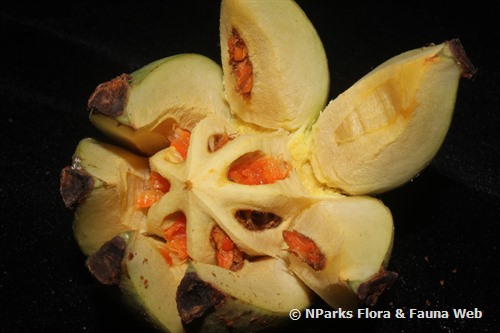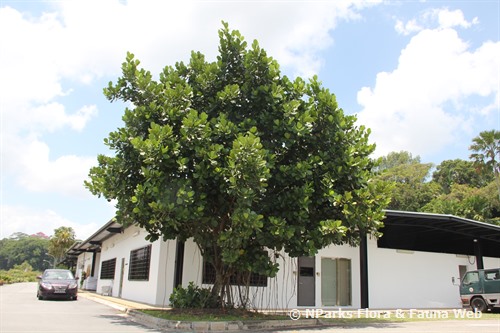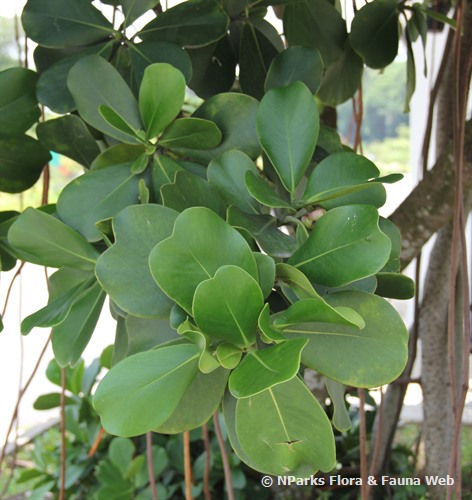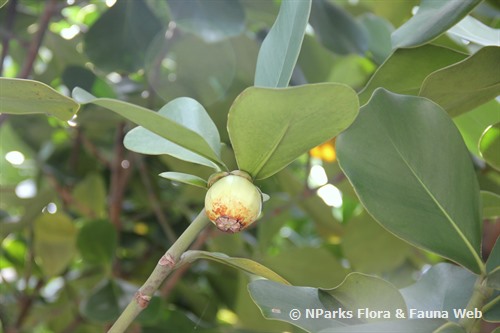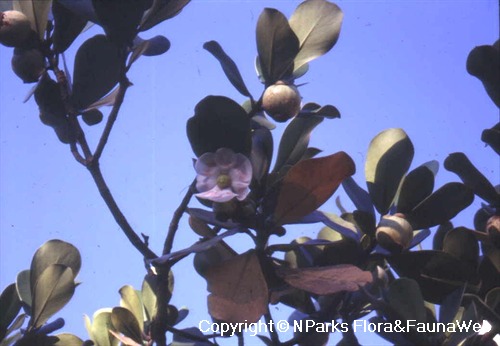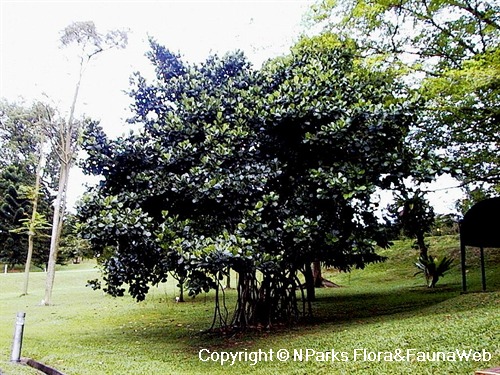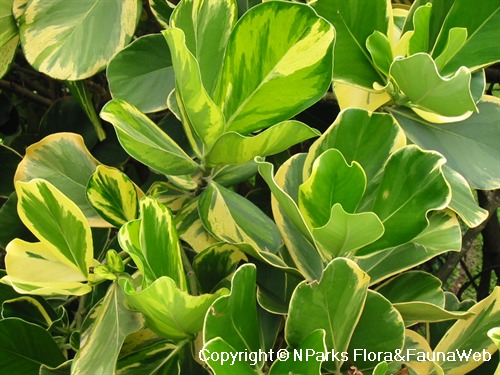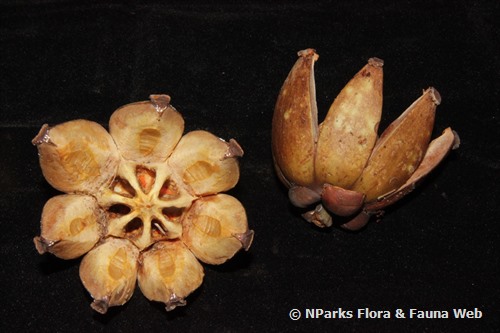
Back
Clusia rosea Jacq.
| Family Name: | Clusiaceae (Guttiferae) |
| Common Name: | Autograph Tree, Balsam Apple, Pitch Apple, Copey, 松脂蘋果, 香脂蘋果 |
Clusia rosea is a tree or hemi-epiphyte with stiff leaves and large showy flowers. Traditionally used as writing paper, the tree earned their common name, Autograph Tree, due to the enduring prominence of words scratched on the leaves even after drying.
Name
Classifications and Characteristics
| Plant Division | Angiosperms (Flowering Seed Plants) (Dicotyledon) |
|---|---|
| Plant Growth Form | Tree |
| Lifespan (in Singapore) | Perennial |
| Mode of Nutrition | Autotrophic |
| Maximum Height | 30 m |
Biogeography
| Native Distribution | From Florida to Ecuador. |
|---|---|
| Native Habitat | Terrestrial |
| Preferred Climate Zone | Tropical |
| Local Conservation Status | Non-native |
Description and Ethnobotany
| Growth Form | It is a tree or hemi-epiphyte, which can reach up to 30 m tall. It has broad and spreading crown with conspicuous aerial roots. It produces yellowish white sap when any parts of the plant are injured. |
|---|---|
| Foliage | Leaves are green, glossy, stiff leathery and in opposite arrangement. Each leaf is egg-shaped (obovate), about 7 – 15 cm long and 6.4 – 15 cm wide. The leaf tip is rounded to notched (emarginate) while the leaf base is wedged shaped (cuneate). The leaf stalk (petiole) is short and about 1 – 2 cm long. |
| Flowers | Flowers occur in clusters of 1 – 3 on the axils or pseudo-terminal position. The flower is large and showy (about 6 – 8 cm diameter). Each flower has 6 – 8 white or pink petals. Male flowers (staminate) have stamens in several whorls and united (connate) at the base, forming a ring. Female flowers (pistillate) have staminodes joined into a cup, globose ovary and 6 – 9 (– 12) stigmas. |
| Fruit | Fruit is round (5 – 8 cm diameter) and capsular. It turns turn greenish brown when ripe and splits into 8 – 9 parts, revealing seeds which are enclosed within a red aril. |
| Habitat | It is found in evergreen and semideciduous forests, up to 500 m altitude, coastal limestones and savannas. |
| Associated Fauna | Seeds are dispersed by birds. |
| Cultivation | It can be propagated by seeds. Seeds may germinate in the branches of other trees and gradually strangle or outgrow the host tree. |
| Etymology | Genus epithet 'Clusia’ is named in honor of Carolus Clusius (1526 – 1609), also known as Charles De L’Ecluse, a pioneering botanist known for introducing new plant species to Europe. His cultivation of tulips in Leiden laid the foundations of the Dutch tulip bulb industry. The specific epithet ‘rosea’, in Latin, means rose-like. |
| Ethnobotanical Uses | Timber & Products: The timber is used for fencepost, furniture and tool handles. Others: It is commonly cultivated for its ornamental foliage. The yellow latex is used for caulking the seams of boats in the Virgin Islands. The dried and powdered latex is used as plaster to treat fractures, dislocations and burns. <3> Traditionally used as writing paper, the tree earned their common name, Autograph Tree, due to the enduring prominence of words scratched on the leaves even after drying. In the 15th century, Spanish conquistadores in the West Indies used these leaves to make playing cards as an alternative to conventional playing cards. |
Landscaping Features
| Landscaping | In Singapore, it is observed to be flowering and fruiting several times a year. |
|---|---|
| Desirable Plant Features | Ornamental Flowers, Ornamental Foliage |
| Landscape Uses | Parks & Gardens, Coastal |
| Usage Hazard - Cons | Toxic Upon Ingestion, Irritant - Sap |
Fauna, Pollination and Dispersal
| Fauna Pollination Dispersal Associated Fauna | Bird-Attracting |
|---|---|
| Seed or Spore Dispersal | Biotic (Fauna) |
Plant Care and Propagation
| Light Preference | Full Sun |
|---|---|
| Water Preference | Moderate Water |
| Plant Growth Rate | Moderate |
| Rootzone Tolerance | Saline Soils / Salt Spray, Moist Soils, Well-Drained Soils |
| Propagation Method | Seed, Stem Cutting |
Foliar
| Mature Foliage Colour(s) | Green |
|---|---|
| Mature Foliage Texture(s) | Leathery |
| Foliar Type | Simple / Unifoliate |
| Foliar Arrangement Along Stem | Opposite |
| Foliar Attachment to Stem | Petiolate |
| Foliar Margin | Entire |
| Foliar Apex - Tip | Rounded, Emarginate |
| Foliar Base | Cuneate |
| Leaf Area Index (LAI) for Green Plot Ratio | 3.0 (Tree - Intermediate Canopy) |
Non - Foliar and Storage
| Trunk Type (Non Palm) | Woody |
|---|
Floral (Angiosperm)
| Flower Colour(s) | White, Pink |
|---|---|
| Flowering Period | A Few Times Yearly |
Fruit, Seed and Spore
| Mature Fruit Colour(s) | Green |
|---|
References
| References | <1> Britton, N. L. and Millspaugh, C.F. (1920). The Bahama Flora. New York: New York Botanical Garden. 695 pages. <2> Flora of North America Editorial Committee (2015). Flora of North America North of Mexico 6: 1-468. Oxford University Press, New York, Oxford. <3> Lemmens, R.H.M.J. and Bunyapraphatsara, N. (eds). (2003). Plant Resources of South-East Asia Volume 12 (3). Medicinal and poisonous plants 3. Leiden: Prosea Foundation, Backhuys Publishers. 664 pages. |
|---|
Image Repository
Others
| Master ID | 1522 |
|---|---|
| Species ID | 2815 |
| Flora Disclaimer | The information in this website has been compiled from reliable sources, such as reference works on medicinal plants. It is not a substitute for medical advice or treatment and NParks does not purport to provide any medical advice. Readers should always consult his/her physician before using or consuming a plant for medicinal purposes. |

